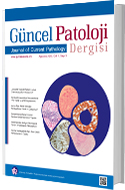2Department Of Neurosurgeryfaculty Of Medicine, Adnan Menderes University, Aydin, Turkey
3Department Of Radiology, Faculty Of Medicine, Adnan Menderes University, Aydin, Turkey
Background: Epithelial cysts of the central nervous system, according to the type of cell origin; neuroepithelial or endodermal type. Endodermal cysts are rare forms of benign tumors. In this presentation, we present a 35-year-old male patient with typical histopathologic features and due to the presence of this rare lesion.
Case Report
A 35-year-old man presented with complaints of waist and right leg pain for about a week. Physical examination showed limitation of waist movement and paravertebral spasm. Neurological examination showed positive leg lift test on the right side at 45-50 degrees, 3/5 muscle loss in the dorsal flexion of the right foot and hypoesthesia in the right L4-S1 dermatomes. On the Lomber MRI examination, L5 sacralization was determined and a mass showing a T1A hyperintense post contrast sera opacification mass, extending from the upper end plate of the T10 vertebra to the upper end plate of the T11 vertebra, and compressing towards the extra axial intradural spinal coronary artery, at 32x11x10 mm in the widest area, was observed. Surgery and excition of mass with preoperatively diagnosis of menengioma was planned.
The material sent for post-operative evaluation consists of a biopsy material in a dark white color with a diameter of 0,4 cm. In the sections, thin fibrous membranous cyst wall with low columnar-ciliary epithelium was observed. The cystic epithelium is locally ciliated and it was rich in goblet cells in the focal areas. Most areas of wall structure was thin and membraneus, in some areas it was thicker and fibrotic. The presence of histiocytes containing a brown pigment in a focal area was observed. Positive staining with Prussian blue applied by histochemical method was observed. Pancytokeratin(diffuse-strong), cytokeratin 7 and EMA staining in cystic epithelium were observed. IHC stains reported negative for glial fibrillary acidic protein (GFAP), cytokeratin 20 (CK20), caudal-type homeobox 2 (CDX2), mucin 2 (MUC2), mucin 5 (MUC5), thyroid transcription factor-1 (TTF-1).
A final diagnosis was “Endodermal Cysts” based on histological and immunohistochemical findings.
Results: The importance of the cell type in the endodermal cyst is also emphasized and the frequency of recurrence in cysts that have goblet-columnar epithelial component. This epithelium is increasing the risk of recurrences. However, the other cause of recurrence is also incomplete excision. Therefore, the complete excision of ECs is important, not only for avoiding recurrence but also for differentiating cell types for ECs and predicting recurrence risk.
Conclusions: The precise pathologic diagnosis of cell type determines the risk of recurrence. Neurosurgeons should exert their best efforts to achieve complete excision of the cysts.
Anahtar Kelimeler : Spinal, endodermal cyst, cell type

